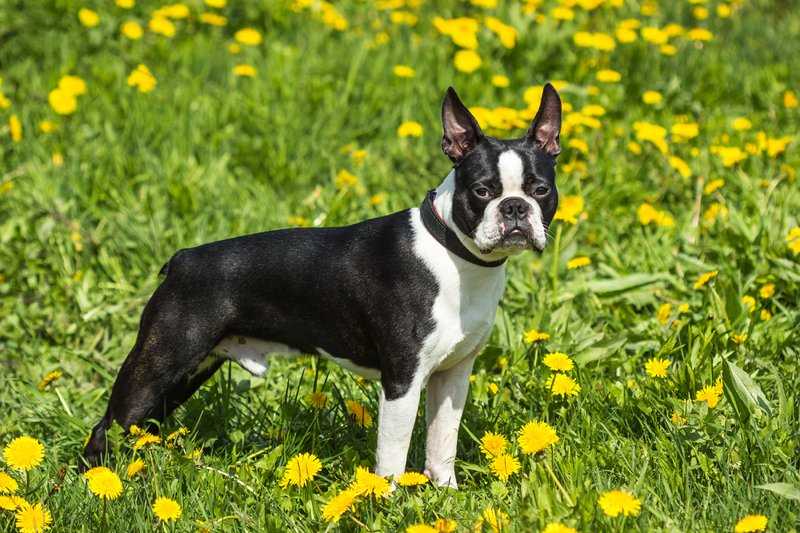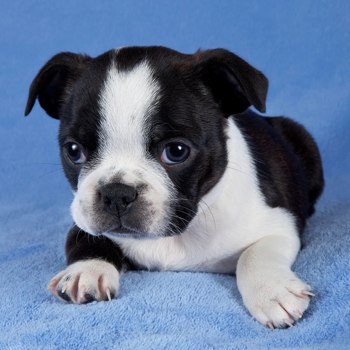Boston Terrier

The Boston Terrier is a lively, intelligent breed with a playful nature. The breed originated from America but was influenced by several other breeds. It is now popular around the world. They are a small compact breed but should not be heavy in appearance. Their distinct ‘tuxedo’ markings give them a charming appearance and they need minimal grooming to keep their coat in good condition and stop shedding around the house.
Boston Terriers are extremely sociable and people friendly little dogs. They can be boisterous so are suited to older children. The breed can be strong-willed at times but are generally keen to please their owners so training is not a particular problem. Breeding for certain characteristics has led to some health issues. They are a brachycephalic breed which means they can have problems breathing and keeping cool in hot or stressful conditions.
About & History
The Boston Terrier originated from America but was influenced by several other breeds including the Bulldog, American Pit Bull Terrier, Bull Terrier, French Bulldog and even the Boxer. It was the first American breed to be recognized by the American Kennel Club. The breed was first recognized in the late 1800’s when bull and terrier breeds were mixed to produce the two dogs from Boston upon which the breed is established. The Boston Terrier was first recognised as a breed by the UK Kennel Club in 1914 and belongs to the utility group, which consist of miscellaneous non-sporting breeds.
Today the Boston Terrier is primarily a companion breed but is also popular in dog sports such as agility, flyball, obedience and rally. They also make good therapy dogs as are friendly with everyone including strangers.
Appearance

The Boston Terrier has several different colours which are accepted for registration by the UK Kennel Club. These include:
- Black and White
- Black and White Brindle
- Black Brindle and White
- Brindle
- Brindle and White
- Mahogany and White
- Mahogany Brindle
- Mahogany Brindle and White
- Red and White
- Seal and White
- Seal Brindle
- Seal Brindle and White
Dogs should have a coat which has a fine texture and is short and smooth to touch. The Boston Terrier should ideally have some white markings to fit the breed standard. These include a white muzzle, a white blaze running between the eyes and over the head and a white collar and breast with part or all of the forelegs being white in colour. It is also preferable for the hind legs to be white from the hocks down.
The Boston Terrier should have an overall square appearance and the length of the body and leg should be balanced, it should not be stocky or spindly. It is a small dog but is divided into different groups within the breed according to weight. These groups are:
- Lightweight – less than 6.8 kg
- Middleweight – 6.8 – 9.1 kg
- Heavyweight – 9.1 – 11.4 kg
The breed is a compact, but balanced bull-breed dog which should have a neck which is slightly arched leading to seamlessly to the shoulders which should be reasonably wide set and sloping. The body should be deep with a wide chest and short muscular back and curved rump giving an appearance of an overall short body but this should not appear chunky. The front legs should be straight and muscular with straight elbows. The back legs should be strong and well muscled and feet should be small and compact. The tail should be low set and short and can be tapering, straight or curled.
The Boston Terrier has a head which should not have wrinkled skin with a square shaped skull and flat forehead and obvious brow. The muzzle should also be square and broad with a wide black nose and even bite with no teeth showing. The head should be in proportion to the overall size of the dog. Eyes should be round and large but not oversized with a kind, alert expression set in line with the cheeks when seen from the front. The ears should be small and thin and carried upright and wide set near to the corners of the skull.
The Boston Terrier should convey a sense of gracefulness and power in its gait. Giving the impression of an ease of movement with front and back legs moving in rhythm with sure footedness.
Character & Temperament
The Boston Terrier is a exceptionally friendly breed, even with strangers. They have a lively, intelligent nature and can be strong-willed, but are generally eager to please. They are generally good with children, although can be boisterous at times, so are suited to slightly older children.
The breed is exceptionally sociable and makes a very good companion dog, although this means that they are prone to suffering from separation anxiety. They are also usually good with other pets if introduced appropriately. Their friendly nature and indifference towards strangers means they do not usually make good guard dogs.
Trainability

Despite their determined character, the Boston Terrier is usually eager to please which means they are easily trainable, hence their more recent popularity in some modern dog sports. This means that recall is not usually a problem as they are keen to remain with their owners. Like with most dogs, which have access to an outside space and/or an established routine for walks, house training is not normally an issue.
Health
Compared to some other brachycephalic and bull breeds the Boston Terrier has fewer characteristics which cause problems and is classed as a Category 1 breed by the UK Kennel Club with no particular points of concern causing welfare issues at the time of writing. As with most breeds though it can suffer from some hereditary health issues. The average life expectancy of the Boston Terrier is around 12 years.
The following tests for conditions which can affect the breed are obligatory for Kennel Club Assured breeders.
Tests for Kennel Club Assured Breeders
- Eye Scheme – The Kennel Club recommends that dogs should be re-examined every year to check for the development of conditions which are either known to be inherited or suspected to be inherited. Boston Terriers suffer from two different types – early and late onset cataracts.
- Hereditary Cataracts (HC-HSF4) – Cataracts cause the lens or capsule to become opaque, worsening over time. If cataracts are complete and affect both eyes they will eventually cause blindness. This test is for the early onset type of cataracts.
Other conditions which can affect the breed include:
Corneal Ulceration
The Boston Terrier has large somewhat protruding eyes and these are prone to becoming damage as they are not well protected. Scratches and bumps can lead to ulceration of the cornea and these can have serious consequences on sight if not treated in time or the eye is repeatedly damaged.
Patellar Luxation
A condition where the equivalent to the kneecap in the hind leg becomes dislocated. This can cause intermittent lameness and be painful. Surgery is needed to correct this in severe cases. Dogs with this condition should not be used for breeding.
Brachycephalic Syndrome
This leads to a condition called BOAS (Brachycephalic Obstructive Airway Syndrome), which is essentially caused by an excessively shortened skull, limiting the space available for internal structures. This lack of space leads to difficulty breathing and can cause the larynx to collapse.
Breathing problems are sometimes exacerbated by an excessively long soft palate. The effects of this condition are seen especially in hot or stressful conditions. If a dog does have difficulty breathing special care should be taken not to exercise it when it is hot and keep it as cool as possible.
Hemivertebrae
Hemi or ‘half’ vertebrae are congenital malformations where vertebrae fail to develop correctly. They are common in many brachycephalic breeds. The malformation causes compression of the spinal cord and this subsequently causes neurological symptoms in the back legs, eventually leading to paralysis if not treated.
Surgery is the only treatment. Any Boston Terrier found to have signs of hemi vertebrae to any extent should not be used for breeding. There is not currently a DNA test available and diagnosis is by evaluation of x-rays.
Sensorineural Deafness
The breed has a higher than normal incidence and this can affect one or both ears. It is thought to be linked to the amount of white in the coat. Dogs which are affected, especially only on one side can still make good pets but should not be bred from. Breeders should have puppies BAER tested to check for this.
Demodectic Mange
Boston Terriers seem to be predisposed to suffering from infestations of Demodex, a type of mite, which is usually found in the skin but does not always cause problems. A compromised immune system or imbalance in the skin can allow the mite to start to cause problems. This is more likely to occur in young dogs.
Birthing Issues
As with many other bull and brachycephalic breeds, the Boston Terrier is prone to problems during birth where puppies’ large heads become stuck. It is not unusual for them to require caesarean sections.
Exercise and Activity Levels
The Boston Terrier is a medium energy breed and needs around an hour of walking each day to stay healthy and happy. Ideally some of this time should be spent off the lead to use up excess energy as some can have a slightly boisterous nature, although this is not essential and a longer lead walk will suffice.
Their small size and relatively low walking requirement means that they can make good dogs for urban environments. The Boston Terrier is a brachycephalic breed and care should be taken not to exercise them when it is very hot or in stressful conditions as they can have breathing difficulties and overheat easily.
Grooming
The Boston Terrier has a short, fine coat which is easy to care for and is a reasonably light shedder. Occasional brushing at home should be sufficient to keep its coat in good condition and prevent hair being left around the house.
Famous Boston Terriers
There are a few well-known films which feature Boston Terriers in them:
- Nuts from the film, The Back Up Plan
- Georgia from the film, Hotel for Dogs
- The dog from the film, Valentine’s Day
- Winston from the short animation, Feast
Cross-Breeds
Some examples of popular Boston Terrier cross-breeds include:
- Bo-Jack – Cross between a Boston Terrier and a Jack Russell Terrier
- Bo-Dach – Cross between a Boston Terrier and a Dachshund
- Bo Shih – Cross between a Boston Terrier and a Shih Tzu
- Boglen Terrier – Cross between a Boston Terrier and a Beagle
- Boskimo – Cross between a Boston Terrier and an American Eskimo Dog
- Bossi-Poo – Cross between a Boston Terrier and a Poodle
- Basston – Cross between a Boston Terrier and a Basset Hound
- Bostillon – Cross between a Boston Terrier and a Papillon
- Frenchton – Cross between a Boston Terrier and a French Bulldog
- Boston Cattle Dog – Cross between a Boston Terrier and an Australian Cattle Dog
- Boston Spaniel – Cross between a Boston Terrier and a Cocker Spaniel
- Boston Huahua – Cross between a Boston Terrier and a Chihuahua
- Boston Lab – Cross between a Boston Terrier and a Labrador Retriever
- Boston Yorkie – Cross between a Boston Terrier and a Yorkshire Terrier
- Brat – Cross between a Boston Terrier and a Rat Terrier
- Bugg – Cross between a Boston Terrier and a Pug
- Boston Bulldog – Cross between a Boston Terrier and an English Bulldog
- Piston – Cross between a Boston Terrier and a Pit Bull
- Pomston – Cross between a Boston Terrier and a Pomeranian
- Bostinese – Cross between a Boston Terrier and a Pekingese

